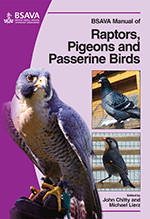
Full text loading...

Raptors have been kept in captivity for many centuries. While the original purpose was for falconry, to obtain meat for the pot, they are now kept for a more diverse range of reasons. This has great relevance to the clinician, as husbandry has a considerable impact on disease. This chapter look into tethered birds, aviaries, falconry equipment and training.
Raptor husbandry and falconry techniques, Page 1 of 1
< Previous page | Next page > /docserver/preview/fulltext/10.22233/9781910443101/9781910443101.2-1.gif

Full text loading...







